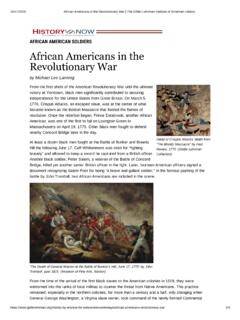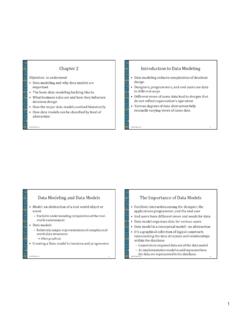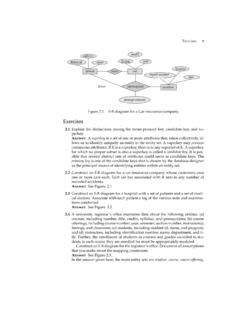Transcription of The Extended Entity Chapter 5 Relationship Model
1 1 Chapter 5 Objectives: to learn about the Extended Entity Relationship (E-ER) Model How Entity clusters are used to represent multiple entities and relationships The characteristics of good primary keys and how to select them using flexible solutions for special data modeling cases1CS275 Fall 2010 The Extended Entity Relationship Model Result of adding more semantic constructs to original Entity Relationship (ER) Model Diagram using this Model is called an EER diagram (EERD) Combines some of the Object-oriented concepts with Entity Relationship Fall 2010 Entity Supertypesand Subtypes Entity supertype Generic Entity type related to one or more Entity subtypes Contains common characteristics Entity subtype Contains unique characteristics of each Entity subtype Avoids unnecessary null attributes when not shared by all super Entity Fall 2010 Supertype/Subtype Relationship in an ERD Example of employee (Super type)
2 , and Professor (Sub type) Note the cardinality for a 1:1 relationship4CS275 Fall 20102 Entity Supertypesand Subtypes Example data set with and without sub-type Entity , where certain employees contain additional Fall 2010 Specialization Hierarchy Depicts arrangement of higher-level Entity supertypesand lower-level Entity subtypes Relationships described in terms of IS-A relationships Subtype exists only within context of supertype Every subtype has only one supertype to which it is directly related Can have many levels of supertype/subtype relationships6CS275 Fall 2010 Inheritance Enables Entity subtype to inherit attributes and relationships of supertype All Entity subtypes inherit their primary key attribute from their supertype At implementation level, supertype and its subtype(s) maintain a 1:1 Relationship Entity subtypes inherit all relationships in which supertypeentity participates Lower-level subtypes inherit all attributes and relationships from all upper-level supertypes7CS275 Fall 2010 Specialization Hierarchy8CS275 Fall 20103 Subtype Discriminator The Subtype Discriminator is an attribute in supertypeentity Determines to which Entity subtype each supertypeoccurrence is related Default comparison condition for subtype discriminator attribute is equality comparison Subtype discriminator may be based on other comparison condition9CS275 Fall 2010 Disjoint and Overlapping Constraints Disjoint subtypes Also called nonoverlappingsubtypes Subtypes that contain unique subset of supertypeentity set Single attribute is coded for the type Overlapping subtypes Subtypes that contain non-unique subsets of supertypeentity set Multiple attributes are necessary.
3 Each representing a possible Fall 2010 Disjoint and Overlapping Constraints Implementing Overlapping subtypes The supertypeentity can hold multiple Fall 2010 Diagramming Symbols for Disjoint & Overlapping ConstraintsDisjoint and Overlapping Constraints12CS275 Fall 20104 Completeness Constraint Specifies whether Entity supertype occurrence must be a member of at least one subtype Partial completeness Some supertypeoccurrences are not members of any subtype symbolized by a circle over a single line Total completeness Every supertypeoccurrence must be member of at least one subtype symbolized by a circle over a double line13CS275 Fall 2010 Completeness Constraint Partial or Total Completeness with Disjoint or Overlapping Fall 2010 Specialization and Generalization Specialization Identifies more specific Entity subtypes from higher-level Entity supertype Top-down process Based on grouping unique characteristics and relationships of the subtypes Generalization Identifies more generic Entity supertypefrom lower-level Entity subtypes Bottom-up process Based on grouping common characteristics and relationships of the subtypes15CS275 Fall 2010 Entity Clustering Virtual Entity type used to represent multiple entities and relationships in ERD Considered virtual or abstract because it is not actually an Entity in final ERD Temporary Entity used to represent multiple entities and relationships Eliminate undesirable consequences Avoid display of attributes when Entity clusters are used16CS275 Fall 20105 Entity Clustering A technique used to simplify the ERD Useful when the target audience of the ERD is not directly involved with the subsystem represented by the virtual Entity .
4 Makes sure that the Relationship to the cluster is not Fall 2010 Selecting Primary Keys Primary key is the most important characteristic of an Entity Single attribute or some combination of attributes Primary key s function is to guarantee Entity integrity, the uniqueness of each Entity row. It s purpose is to guarantee uniqueness, not to describe the Entity Primary keys and foreign keys work together to implement relationships Properly selecting primary key has direct bearing on efficiency and effectiveness18CS275 Fall 2010 Primary Key Guidelines19CS275 Fall 2010 Selecting Primary Keys A Natural keyis a real-world identifier used to uniquely identify real-world objects Familiar to end users and forms part of their day-to-day business vocabulary is generally used as the primary key of Entity being modeled Compositekeys are useful in two cases: As identifiers of composite(bridge) entities As identifiers of weak entities Surrogatekeys may be generated when a Natural or Composite key is not Fall 20106 Use of Composite Primary Keys As identifier of Composite Entity Enroll21CS275 Fall 2010 Use of Composite Primary Keys As identifier of a Weak Entity Dependent Entity exists only when it is related to parent entity22CS275 Fall 2010 Use of Surrogate Primary Keys Especially helpful when there is:1.
5 No natural key2. Selected candidate key has embedded semantic contents3. Selected candidate key is too long or cumbersome If you use surrogate key, ensure the candidate key of Entity in question performs properly through use of unique index and not null constraints23CS275 Fall 2010 Using Surrogate Primary Keys Example - Data set for Events Uniqueness requires multiple attributes Composite key is cumbersome and has embedded Fall 20107 Design Cases: Learning Flexible Database Design Data modeling and design requires skills acquired through experience Experience acquired through practice Four special design cases that highlight: Importance of flexible design Proper identification of primary keys Placement of foreign keys25CS275 Fall 2010 Design Case #1: Implementing 1:1 Relationships Foreign keys work with primary keys to properly implement relationships in relational Model Although conceivable to have put the primary key of each table into the other table as a foreign key, it is unnecessary.
6 Put primary key of the one side (parent Entity ) on the many side (dependent Entity ) as foreign key26CS275 Fall 2010 Design Case #1: Implementing 1:1 Relationships 27CS275 Fall 2010 Design Case #2: Maintaining History of Time-Variant Data Time-variant data refers to data whose values change over time and for which you must keep a history of data changes Values change over time Must keep a history of data changes Keeping history of time-variant data equivalent to having a multivalued attribute in your Entity Must create new Entity in 1:M relationships with original Entity New Entity contains new value, date of change28CS275 Fall 20108 Design Case #2: Maintaining History of Time-Variant Data29CS275 Fall 2010 Design Case #2: Maintaining History of Time-Variant Data30CS275 Fall 2010 Design Case #3: Fan Traps Design trap occurs when Relationship is improperly or incompletely identified Represented in a way not consistent with the real world Most common design trap is known as fan trap Fan trap occurs when one Entity is in two 1:M relationships to other entities Produces an association among other entities not expressed in the model31CS275 Fall 2010 Design Issue #3: Fan Traps32CS275 Fall 20109 Design Case #4:Redundant Relationships Redundancy is seldom a good thing in database environment Occurs when there are multiple Relationship paths between related entities Some designs use redundant relationships to simplify the design, or to account for time-variant data.
7 The concern is that redundant relationships remain consistent across model33CS275 Fall 2010 Design Case #4: Redundant Relationships Player relates to Division Player relates to Team which relates to Division34CS275 Fall 2010 Summary Extended Entity Relationship (EER) Model adds semantics to ER Model Adds semantics via Entity supertypes, subtypes, and clusters Entity supertypeis a generic Entity type related to one or more Entity subtypes Specialization hierarchy Depicts arrangement and relationships between Entity supertypesand Entity subtypes Inheritance means an Entity subtype inherits attributes and relationships of supertype35CS275 Fall 2010 Summary Subtype discriminator determines which Entity subtype the supertype occurrence is related to: Partial or total completeness Specialization vs. generalization Entity cluster is virtual Entity type Represents multiple entities and relationships in ERD Formed by combining multiple interrelated entities and relationships into a single object Natural keys are identifiers that exist in real world Sometimes make good primary keys36CS275 Fall 201010 Summary Characteristics of primary keys: Must have unique values Should be nonintelligent Must not change over time Preferably numeric or composed of single attribute Composite keys are useful to represent M:N relationships Weak (strong-identifying) entities Surrogate primary keys are useful when no suitable natural key makes primary key37CS275 Fall 2010 Summary For 1.
8 1 Relationship , put the PK of mandatory Entity As FK in optional Entity As FK in Entity that causes least number of nulls As FK where the role is played Time-variant data Data whose values change over time Requires keeping a history of changes To maintain history of time-variant data: Create Entity containing the new value, date of change, other time-relevant data Entity maintains 1:M Relationship with Entity for which history maintained38CS275 Fall 2010 Summary Fan trap: One Entity in two 1:M relationships to other entities Association among the other entities not expressed in Model Redundant relationships occur when multiple Relationship paths between related entities Main concern is that they remain consistent across the Model Data modeling checklist provides way to check that the ERD meets minimum requirements (see the front cover, inside page)39CS275 Fall 2010










